17 Home Remedies To Treat Dust Allergy: Causes, Symptoms, And Prevention Tips
Beware that pollen and dust are not the only major triggers behind your runny nose.
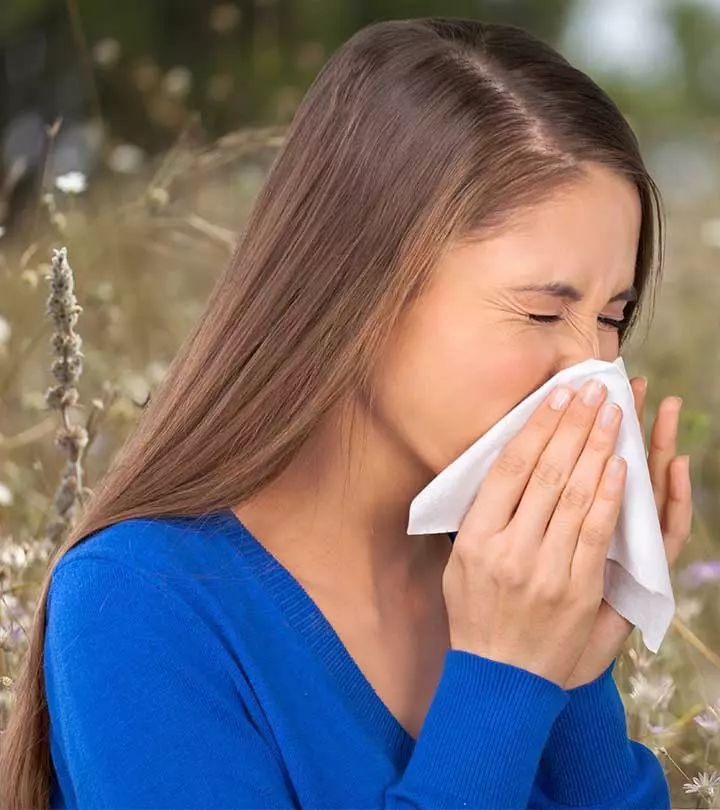
Image: Shutterstock
If you are troubled by dust allergy, fret not. We got you covered! You can easily treat dust allergies at home. While pollen, food choices, weather, humidity, dust, and pollution can all lead to some allergic reactions, dust allergy often seems to get mistaken for frequent episodes of common cold and low immunity. To help you deal with dust allergy effectively, we have shortlisted some of the simplest home remedies that can help manage the symptoms. Read on.
In This Article
What Causes Dust Allergy?
Dust mites are the main culprits behind dust allergy. Listed below are a few other causes:
- Pollen – Pollen is a fine powdery substance that consists of pollen grains. It is a natural part of trees, flowers, and grasses. Different people may be allergic to different types of pollen.
- Cockroaches – Cockroach droppings can cause dust allergy in some individuals when inhaled (1). These tiny particles often combine with household dust to cause allergy.
- Mold – Mold is a kind of fungus that has spores that are capable of floating in the air. These spores can also cause dust allergy (1).
- Yeast – Yeast is a cousin of mold, and you can have an overgrowth of yeast called Candida albicans in your intestines due to the overuse of antibiotic medication. Yeast can also colonize your nasal mucous membranes and sinuses, making them irritated and susceptible to dust allergies (1).
- Animal Hair, Fur, And Feathers – Pets are another cause of dust allergy (2). Their skin flakes (called dander), urine, or saliva are potential allergens, especially when combined with dust.
There are many ways you can diagnose if you have a dust allergy or not. Learn them in the section below.
 Trivia
TriviaDiagnosis
- Medical History: Healthcare providers begin by discussing the symptoms, their duration, and potential triggers.
- Physical Examination: A physical examination helps identify visible signs of the allergy, such as nasal congestion or skin reactions.
- Allergy Testing: To confirm a dust mite allergy, skin-prick tests or blood tests may be conducted. These tests help identify specific allergens that trigger your symptoms.
- Environmental Assessment: Assessing your home environment for potential dust sources is crucial. Your healthcare provider might inquire about your living conditions and habits.
- Elimination Tests: Your doctor may suggest an elimination diet or environmental control measures to determine if your symptoms improve when exposed to fewer allergens.
- Challenges or Provocation Tests: In rare cases, a controlled exposure to suspected allergens under medical supervision may be used to diagnose specific allergies.
Dust allergy is often accompanied by non-stop sneezing and cold-like symptoms. The signs and symptoms are discussed below.
What Are The Signs And Symptoms Of Dust Allergy?
The most common symptoms of dust allergy are (3):
- A runny nose
- Sneezing and sniffling
- Itchy and red eyes
- Itching
- Coughing and wheezing
- Shortness of breath
- Tightness in the chest
Charlie Maginness, a YouTuber, talked about his struggle with dust allergy in his video. He said, “I used to be sneezing all the time, I used to have really watery and runny eyes, and my immune system was just sort of just always fighting (i).” He further added that he felt sick and tired most of the time.
While it is difficult to get rid of dust mites altogether, you can try some easy treatments that will help you tackle the allergens effectively. Listed below are a few home remedies for dust allergy.
Home Remedies For Dust Allergy
- Essential Oils
- Local Honey
- Humidifier
- Air Filter
- Apple Cider Vinegar
- Turmeric
- Aloe Vera
- Neti Pot
- Vitamins
- Peppermint Tea
- Nettle Leaf
- Green Tea
- Ghee
- Wasabi
- Homeopathic Remedies
- Houseplants
- Herbal Tea
1. Essential Oils

(a) Eucalyptus Essential Oil
Eucalyptus essential oil was shown to have high activity against house dust mites.
Its constituents act as ecofriendly biodegradable agents for the control of house dust mites (4).
You Will Need
3-4 drops of eucalyptus essential oil
What You Have To Do
Add a few drops of eucalyptus essential oil to a diffuser and inhale its vapors.
How Often You Should Do This
Do this 1-2 times daily.
(B) Lavender Essential Oil
Lavender oil has anti-inflammatory and analgesici A type of pain reliever or painkilling drug used to relieve different degrees of pain ranging from headaches to joint pain. properties
(5), (6). It can also help you sleep better with its sedative nature (7). This may help manage the symptoms of dust allergy.
You Will Need
2-3 drops of lavender essential oil
What You Have To Do
Put a few drops of lavender oil in your diffuser and inhale its vapors.
How Often You Should Do This
Do this once daily.
2. Local Honey
Local and raw honey often contains small amounts of local pollen, which is believed to help with dust allergies. Touted as one of the common home remedies for allergies, consuming local honey regularly is thought to help the body build immunity against local allergens.
This is mainly useful for those who have seasonal allergies as regular consumption of small amounts of pollen via raw honey may make an individual less sensitive to it over time (8).
You Will Need
2 teaspoons of raw honey
What You Have To Do
Consume two teaspoons of raw honey.
How Often You Should Do This
Do this 2 times daily.
3. Dehumidifier
Dehumidifiers are devices that pull moisture out of the air, drying it out, thereby keeping mold triggers at bay
(9). Dust allergy is often caused by dust mites and molds, both of which thrive in humid conditions. Hence, a dehumidifier is your best bet to relieve dust allergy and its symptoms.
4. Air Filter
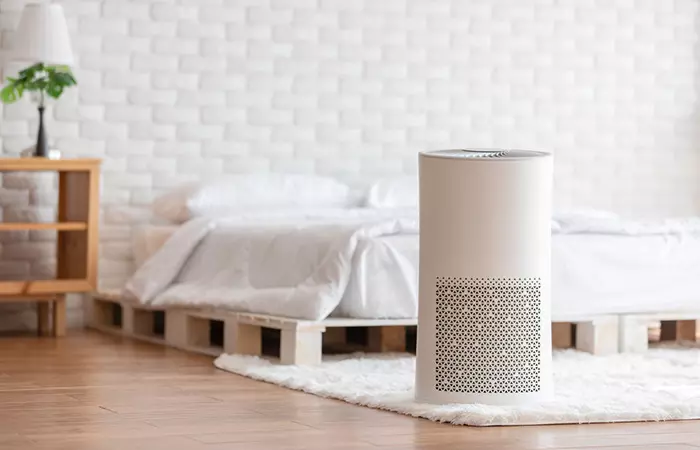
Air filters also play a major role in filtering and purifying the air around you. Studies show how these filters, especially those available today with advanced technologies, can improve indoor air quality (10). The finer the sieve of the filter, the smaller the particles it can trap. Using air filters can also help ease allergic respiratory diseases (11).
5. Apple Cider Vinegar
The anti-inflammatory properties of apple cider vinegar, along with its expectoranti A type of cough medicine that helps get rid of phlegm in the air passageways and clears congestion. nature, can help in treating dust allergy and the accompanying cold-like symptoms. ACV also has antimicrobial properties that can prevent aggravation of the allergy (12). It is a natural substitute for the store-bought antihistamines used for treating dust allergies. However, there is no scientific evidence to prove this effect.
You Will Need
- 2 teaspoons of apple cider vinegar
- 1 glass of warm water
- Honey (optional)
What You Have To Do
- Add two teaspoons of apple cider vinegar to a glass of warm water and mix well.
- You can also add a little honey for flavor.
- Consume this solution.
How Often You Should Do This
Drink this solution 2-3 times daily.
6. Turmeric
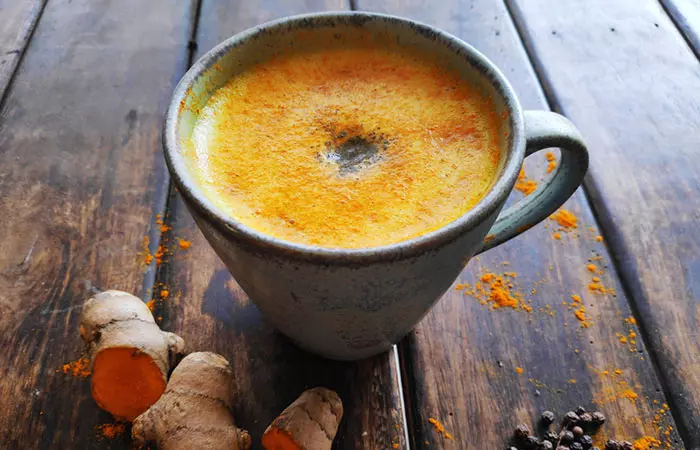
This golden spice is one of the best natural remedies for treating dust allergy. Using turmeric for allergies can be particularly effective due to its various properties. Turmeric contains an active constituent called curcumin that acts as a natural decongestant. It also acts as a natural antihistamine, i.e., it reduces the release of histamines in the body, which can otherwise trigger allergy (13). Additionally, turmeric also has anti-inflammatory and antibacterial properties that can prevent your allergy from turning into an infection (14).
You Will Need
- 1/2 teaspoon of turmeric
- 1 cup of milk
- A pinch of pepper
- Honey (optional)
What You Have To Do
- Add half a teaspoon of turmeric to a cup of milk.
- Bring this just short of boiling in a saucepan. The boiled milk will curdle.
- Add honey and allow the milk to cool.
- Drink this mixture.
How Often You Should Do This
Do this at least 2 times daily.
7. Aloe Vera
Aloe vera has natural anti-inflammatory and analgesic properties (15), (16). It can help treat the swelling and pain caused by dust allergies. However, there are no scientific studies supporting its effect on dust allergy.
You Will Need
1/4 cup of aloe vera juice
What You Have To Do
Drink one-fourth cup of aloe vera juice.
How Often You Should Do This
Do this 2 times daily.
8. Neti Pot
Saline nasal sprays are an age-old method of relieving symptoms of nasal congestion and irritation. If you are wondering how to get rid of a stuffy nose, using a neti pot is highly effective. A neti pot not only rinses trapped dust and mold but also reduces congestion and helps control the inflammation and swelling caused due to the dust allergy (17).
You Will Need
- A neti pot
- Saltwater
What You Have To Do
- Fill your neti pot with saltwater. The ratio is ½ to 1 teaspoon of salt to two cups of warm water. Adding ¼ teaspoon of baking soda per cup can keep the salt from drying the mucous membranes.
- Bend over a washbasin with one ear parallel to the sink and insert the neti pot spout into one nostril. Pour half the solution into one nostril.
- The saltwater will automatically flow from the other nostril.
- Insert the spout in the other nostril and repeat the process.
How Often You Should Do This
Do this 2-3 times daily.
9. Vitamins
Vitamin C
is widely known for its antioxidant potential. Vitamin C supplementation can help treat dust and seasonal allergies (18), (19). This is because it not only prevents the release of histamines but also helps speed up their breakdown. An increase in the levels of histamines is known to cause extreme allergic reactions.
A diet rich in citrus fruits and leafy green vegetables will increase your daily intake of vitamin C. You can also opt for additional supplements at a moderate dosage of 500 mg to 1,000 mg per day after consulting your doctor.
10. Peppermint Tea
Rat studies show that peppermint has anti-inflammatory and decongestant properties (20). It contains a volatile oil called menthol that rises to the sinuses and acts as a natural decongestant, providing immediate relief from sneezing, wheezing, and a runny nose (21). This can help in relieving the symptoms of dust allergy.
You Will Need
- 1 teaspoon of dried peppermint leaves
- 1 cup of hot water
- Honey
What You Have To Do
- Add a teaspoon of dried peppermint leaves to a cup of hot water and allow it to steep for 10 minutes.
- Strain the tea and allow it to cool a bit.
- Add honey to it.
- Drink it up.
How Often You Should Do This
You can drink peppermint tea 2 times daily.
11. Nettle Leaf Tea
Nettle leaves
are derived from the stinging nettle plant. This plant has natural anti-histamine properties that reduce the release of the allergy-causing histamines within your body (22). This, in turn, reduces the symptoms of dust allergy. The anti-inflammatory properties of this plant help reduce the inflammation and swelling of the airways that occurs as a result of the allergy (23). It has been a go-to solution for dust allergies for decades.
You Will Need
- 1 teaspoon of dried nettle leaves
- 1 cup of water
- Honey
What You Have To Do
- Boil a teaspoon of dried nettle leaves with a cup of water in a saucepan.
- Simmer for 5 minutes and strain the tea.
- Allow it to cool for some time. Add a little honey and consume it.
How Often You Should Do This
You can drink nettle tea 2-3 times daily.
12. Green Tea
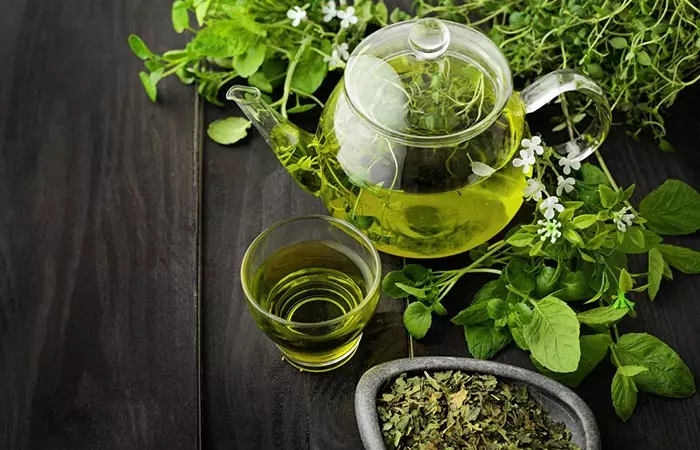
Green tea has been found to help treat a wide range of allergies. It is abundant in a catechini A naturally occurring chemical compound abundantly found in tea, cocoa, and berry plants rich in antioxidant properties. called epigallocatechin gallate (EGCG), which has antioxidant properties and helps treat dust allergy and its symptoms (24), (25).
You Will Need
- 1 green tea bag
- 1 cup of hot water
- Honey
What You Have To Do
- Steep a green tea bag in a cup of hot water for 5-10 minutes.
- Make sure that your tea has cooled a little before adding some honey as required.
- Consume it.
How Often You Should Do This
Drink green tea 3-4 times daily.
13. Ghee

Pure ghee can help warm your nasal passage and relieve constant sneezing. Hence, it is widely used in treating dust allergy and its symptoms. This is mainly due to its anti-inflammatory properties (26). However, there is a lack of scientific evidence to establish the efficacy of ghee in treating dust allergies.
You Will Need
- 1/4 teaspoon of ghee
- Jaggery (cane sugar), optional
What You Have To Do
- If you are sneezing uncontrollably due to an allergy, suck on one-fourth teaspoon of ghee for immediate relief.
- You can also mix ghee with a little jaggery for better results.
How Often You Should Do This
You can consume this whenever you get sudden allergy attacks.
14. Wasabi
Wasabi is also known as Japanese horseradish. It contains a compound called allyl isothiocyanate, which acts as a decongestant and stimulates mucous flow, thereby helping to ease the symptoms of dust allergy. You can also consume the common horseradish if you are unable to get hold of wasabi (27).
Note: Wasabi is very strong. Hence, start with an amount the size of a pearl.
You Will Need
1/4 teaspoon of grated wasabi
What You Have To Do
- Consume grated wasabi whenever you experience allergy symptoms.
- Alternatively, you can also consume wasabi paste.
How Often You Should Do This
Do this whenever you experience an allergy attack.
15. Homeopathic Remedies
Homeopathy has developed many remedies for allergies. The top five are Arsenic alb, Sulphur, Natrum mur, Sabadilla, and Allium cepa. There are also combination homeopathic remedies. However, it is important to consult a homeopathic practitioner before trying out any of these.
16. House Plants
You may also consider keeping a few allergy-friendly plants inside your home to combat dust allergy. Plants like dracaena can be quite useful in trapping allergens in their leaves. Other plants like bamboo and lady palm help keep insects at bay and also act as air purifiers and air filters (28), (29).
17. Herbal Tea
This includes tea from herbs like tulsi, licoricei A herb whose root bears a sweet aromatic flavor and has antioxidant, anti-inflammatory, and antimicrobial properties. , ginger, cinnamon, and cardamom. Studies show that ginger has anti-inflammatory properties. Ginger can help modulate the immune response that is associated with asthma and other related allergic conditions (30). However, ginger may interact with certain drugs, including Coumadin and aspirin. Hence, exercise caution. Moreover, herbal teas are also considered one of the best home remedies for asthma. However, medical advice can’t be negated.
Cinnamon contains polyphenolsi Naturally occurring compounds are found in fruits, vegetables, and beverages with antioxidant properties. that possess antiasthmatic and antiallergic potential (31). Licorice contains glycyrrhizin, which also exhibits anti-inflammatory and antiviral properties (32).
 Quick Tip
Quick TipAyurveda sure does have wonderful solutions for dust allergies. But make sure you check with an Ayurveda consultant for diagnosis and medical prescriptions.
Medicines For Dust Allergy
Your doctor might prescribe antihistamines to relieve sneezing and runny nose and nasal corticosteroids to combat inflammation. Decongestants are given to shrink stuffy nasal passages. However, though antihistamines can help lessen allergy symptoms, they can worsen the next attack. Corticosteroids can make your mucous membranes thinner and make things worse in the long run. Therefore, take these medicines only under medical surveillance.
In addition to these remedies, you can also follow the tips mentioned below to reduce your exposure to indoor dust.
Preventive Tips
- Get rid of wall to wall carpeting, especially in your bedroom.
- Try and keep your pets outside the bedroom and, if possible, outside your house.
- Keep your indoors humidity-free.
- Use mite-proof linens on your beds and pillows.
- Use a high-efficiency filter in your air conditioning unit.
- If your house is invaded by cockroaches, schedule regular visits by the pest control services.
- Keep your house clean and dust-free by vacuuming. You can use a central vacuum or vacuum with a HEPAi High-efficiency particulate absorbing filter refers to the efficiency standard that air filters must meet. filter for this purpose.
- Avoidance of direct exposure to fog and cold weather (especially in the morning) can help. You may want to cover your head if you need to go out.
- Avoid cold drinks, ice creams, fried, and reheated foods.
- Eat seasonal and local fruits and vegetables.
Infographic: Treat Your Dust Allergy With These 5 DIY Home Remedies
Dust allergy can cause discomfort and hinder your daily activities. While most may warrant a medical treatment, certain home remedies can also offer additional relief. In the following infographic, we have listed some remedies you can use to start feeling better. Check it out!

Illustration: StyleCraze Design Team
Dust mites, pollen, cockroach droppings, animal fur, yeast, and mold mixed in the dust are often the culprits behind dust allergy. Coughing, wheezing, sneezing, watery eyes, runny nose, and tightness in the chest are common symptoms of dust allergy, which is why most people confuse a dust allergy for a bout of cold. Home remedies for dust allergy involve the use of humidifiers, essential oils, herbal teas, honey, and vitamins, among other things. Most of these remedies are safe but warrant further scientific research into their efficacy. One can also opt for immunotherapy to prevent frequent allergy attacks. To prevent dust allergy, try to keep your indoors dust-free. It is important to consult a medical professional if symptoms persist for over a week or your health condition deteriorates.
Frequently Asked Questions
How to stop sneezing due to dust allergy?
If you cannot stop sneezing due to a dust allergy, the first thing you need to do is get rid of or avoid whatever is causing it. You can also change your furnace, avoid keeping pets indoors, wash all the linens, and vacuum and keep your indoors dust-free to avoid sneezing from dust allergy.
Try an experiment. Stay away from your house for a few days. If your allergies clear and then come back when you return to your house, you know where the problem lies.
Can you kill dust mites with Lysol?
Yes, Lysol can kill all the germs in your house, including dust mites. This is due to its disinfectant properties. Lysol is also quite helpful in killing other dust allergy-causing particles like molds and mildew (32).
What can I be allergic to in my house?
As discussed earlier, you can be allergic to a lot of particles like dust mites, cockroaches, pollen, or molds. Some individuals may also be allergic to animal hair, fur, or feathers and must avoid keeping pets.
What are seasonal allergies?
Seasonal allergy, also called seasonal allergic rhinitis, is mostly known as hay fever. When the immune system of an individual overreacts to an allergen, it can lead to hay fever. The most common cause of such an allergic reaction is the pollen from weeds and trees. Although it is possible to experience seasonal allergies all year round, the condition is notably less prevalent during winters.
How long does dust allergy last?
Dust allergy symptoms may last anywhere between a day and a week or as long as one is exposed to the allergen.
How do you test for dust allergy?
You can test for dust allergy by undergoing an allergy skin test. The healthcare provider will prick the skin with dust mite extract and observe for 15 minutes to notice any signs of an allergic reaction, such as redness, itchiness, and hives.
Key Takeaways
- Pollen, mold, yeast, and animal hair are the main reasons behind dust allergy.
- It may cause a runny nose, itching, and tightness in the chest.
- Avoiding the use of feather pillows and using HEPA filters or vacuum cleaning your house can keep it dust-free.
- Using apple cider vinegar, turmeric, and aloe vera may help reduce the swelling and pain caused by dust allergies.
Illustration: Home Remedies To Treat Dust Allergy: Causes Symptoms And Prevention Tips
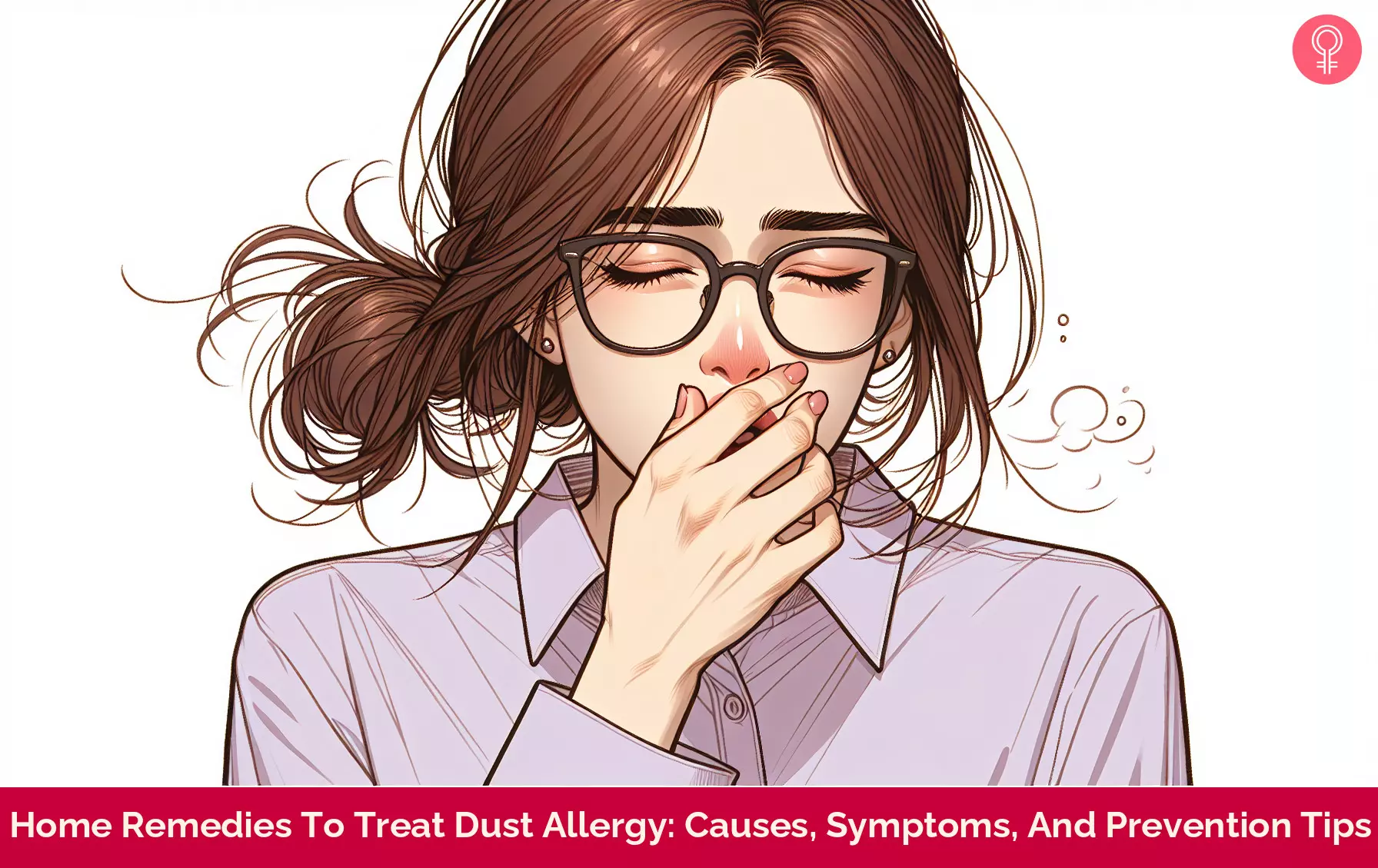
Image: Dall·E/StyleCraze Design Team
Check out the informative video below and discover effective ways to alleviate dust allergies. Gain valuable tips on minimizing exposure, effectively managing symptoms, and finding much-needed relief for a more comfortable life.
Personal Experience: Source
StyleCraze's articles are interwoven with authentic personal narratives that provide depth and resonance to our content. Below are the sources of the personal accounts referenced in this article.
i. How to cure dust allergy | How I did ithttps://www.youtube.com/watch?v=4Jngxe69lg0
References
Articles on StyleCraze are backed by verified information from peer-reviewed and academic research papers, reputed organizations, research institutions, and medical associations to ensure accuracy and relevance. Read our editorial policy to learn more.
- Household mold and dust allergens: Exposure, sensitization and childhood asthma morbidity, Environmental Research, US National Library of Medicine, National Institutes of Health.
https://www.ncbi.nlm.nih.gov/pmc/articles/PMC3604733/ - Recent Understandings of Pet Allergies, F1000 Research, US National Library of Medicine, National Institutes of Health.
https://www.ncbi.nlm.nih.gov/pmc/articles/PMC4755411/ - Dust mite allergies: Overview, InformedHealth.org, The National Center for Biotechnology Information.
https://www.ncbi.nlm.nih.gov/books/NBK447098/ - Acaricidal activities of some essential oils and their monoterpenoidal constituents against house dust mite, Dermatophagoides pteronyssinus (Acari: Pyroglyphidae), Journal of Zhejiang University. Science. B, US National Library of Medicine, National Institutes of Health.
https://www.ncbi.nlm.nih.gov/pmc/articles/PMC1661675/ - Antioxidant, analgesic and anti-inflammatory effects of lavender essential oil, Anais da Academia Brasileira de Ciências, US National Library of Medicine, National Institutes of Health.
https://pubmed.ncbi.nlm.nih.gov/26247152/ - Lavender essential oil inhalation suppresses allergic airway inflammation and mucous cell hyperplasia in a murine model of asthma, Life Sciences, US National Library of Medicine, National Institutes of Health.
https://pubmed.ncbi.nlm.nih.gov/24909715/ - Lavender and the Nervous System, Evidence-Based Complementary and Alternative Medicine, US National Library of Medicine, National Institutes of Health.
https://www.ncbi.nlm.nih.gov/pmc/articles/PMC3612440/ - Ingestion of honey improves the symptoms of allergic rhinitis: evidence from a randomized placebo-controlled trial in the East coast of Peninsular Malaysia, Annals of Saudi Medicine, US National Library of Medicine, National Institutes of Health.
https://pubmed.ncbi.nlm.nih.gov/24188941/ - Reducing relative humidity is a practical way to control dust mites and their allergens in homes in temperate climates, The Journal of Allergy and Clinical Immunology, US National Library of Medicine, National Institutes of Health.
https://pubmed.ncbi.nlm.nih.gov/11149998/ - Enhancing indoor air quality –The air filter advantage, Lung India, US National Library of Medicine, National Institutes of Health.
https://www.ncbi.nlm.nih.gov/pmc/articles/PMC4587002/ - Effectiveness of Air Filters and Air Cleaners in Allergic Respiratory Diseases: A Review of the Recent Literature, Current Allergy and Asthma Reports, US National Library of Medicine, National Institutes of Health.
https://www.ncbi.nlm.nih.gov/pmc/articles/PMC3165134/ - Authenticating apple cider vinegar’s home remedy claims: antibacterial, antifungal, antiviral properties and cytotoxicity aspect, Natural Product Research, US National Library of Medicine, National Institutes of Health.
https://pubmed.ncbi.nlm.nih.gov/29224370/ - Immunomodulatory effects of curcumin in allergy, Molecular Nutrition & Food Research, US National Library of Medicine, National Institutes of Health.
https://pubmed.ncbi.nlm.nih.gov/18398870/ - Turmeric, the Golden Spice, National Center for Biotechnology Information.
https://www.ncbi.nlm.nih.gov/books/NBK92752/ - [Molecular biological study of aloe vera in the treatment of experimental allergic rhinitis in rat], Journal of Clinical Otorhinolaryngology, US National Library of Medicine, National Institutes of Health.
https://pubmed.ncbi.nlm.nih.gov/12592663/ - Antiinflammatory activity of extracts from Aloe vera gel, Journal of Ethnopharmacology, US National Library of Medicine, National Institutes of Health.
https://pubmed.ncbi.nlm.nih.gov/9121170/ - Nasal irrigation for chronic sinus symptoms in patients with allergic rhinitis, asthma and nasal polyposis: a hypothesis generating study, State Medical Society of Wisconsin, US National Library of Medicine, National Institutes of Health.
https://www.ncbi.nlm.nih.gov/pmc/articles/PMC2755042/ - Autoimmune disease and allergy are controlled by vitamin C treatment, In vivo, US National Library of Medicine, National Institutes of Health.
https://pubmed.ncbi.nlm.nih.gov/7919130/ - Effect of vitamin C on histamine bronchial responsiveness of patients with allergic rhinitis, Annals of Allergy, US National Library of Medicine, National Institutes of Health.
https://pubmed.ncbi.nlm.nih.gov/2221490/ - Effects of peppermint (Mentha piperita L.) extracts on experimental allergic rhinitis in rats, Biological and Pharmaceutical Bulletin, US National Library of Medicine, National Institutes of Health.
https://pubmed.ncbi.nlm.nih.gov/11201253/ - Menthol: effects on nasal sensation of airflow and the drive to breathe, Current Allergy and Asthma Reports, US National Library of Medicine, National Institutes of Health.
https://pubmed.ncbi.nlm.nih.gov/12662469/ - Nettle extract (Urtica dioica) affects key receptors and enzymes associated with allergic rhinitis, Phytotherapy Research, US National Library of Medicine, National Institutes of Health.
https://pubmed.ncbi.nlm.nih.gov/19140159/ - Randomized, double-blind study of freeze-dried Urtica dioica in the treatment of allergic rhinitis, Planta Medica, US National Library of Medicine, National Institutes of Health.
https://pubmed.ncbi.nlm.nih.gov/2192379/ - Antioxidant effects of green tea, Molecular Nutrition & Food Research, US National Library of Medicine, National Institutes of Health.
https://www.ncbi.nlm.nih.gov/pmc/articles/PMC3679539/ - Human clinical studies of tea polyphenols in allergy or life style-related diseases, Current Pharmaceutical Design, US National Library of Medicine, National Institutes of Health.
https://pubmed.ncbi.nlm.nih.gov/23448449/ - The effect of ghee (clarified butter) on serum lipid levels and microsomal lipid peroxidation, Ayu, US National Library of Medicine, National Institutes of Health.
https://www.ncbi.nlm.nih.gov/pmc/articles/PMC3215354/ - Functional properties of wasabi and horseradish, Biofactors, US National Library of Medicine, National Institutes of Health.
https://pubmed.ncbi.nlm.nih.gov/11237192/ - House-plant placement for indoor air purification and health benefits on asthmatics, Environmental Health and Toxicology, US National Library of Medicine, National Institutes of Health.
https://www.ncbi.nlm.nih.gov/pmc/articles/PMC4258716/ - Planting Healthier Indoor Air, Environmental Health Perspectives, US National Library of Medicine, National Institutes of Health.
https://www.ncbi.nlm.nih.gov/pmc/articles/PMC3230460/ - Zingiber Officinale Ameliorates Allergic Asthma via Suppression of Th2-mediated Immune Response, Pharmaceutical Biologys, US National Library of Medicine, National Institutes of Health.
https://pubmed.ncbi.nlm.nih.gov/25420680// - Ameliorative Effects of type-A Procyanidins Polyphenols From Cinnamon Bark in Compound 48/80-induced Mast Cell Degranulation, Anatomy & Cell Biology, US National Library of Medicine, National Institutes of Health.
https://pubmed.ncbi.nlm.nih.gov/29354299// - Antioxidant Status and Immune Activity of Glycyrrhizin in Allergic Rhinitis Mice, International Journal of Molecular Sciences, CiteSeerx, The Pennsylvania State University.
https://citeseerx.ist.psu.edu/viewdoc/download?doi=10.1.1.291.5172&rep=rep1&type=pdf - Quercetin and Its Anti-Allergic Immune Response
https://www.ncbi.nlm.nih.gov/pmc/articles/PMC6273625/
Read full bio of Vd. Naveen Sharma
Read full bio of Ravi Teja Tadimalla
Read full bio of Dipti Sharma







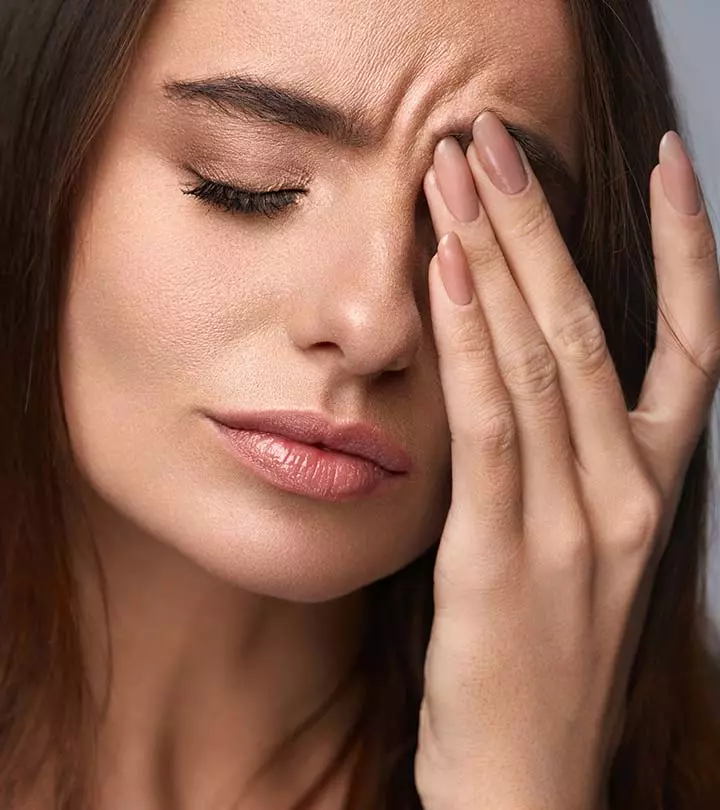





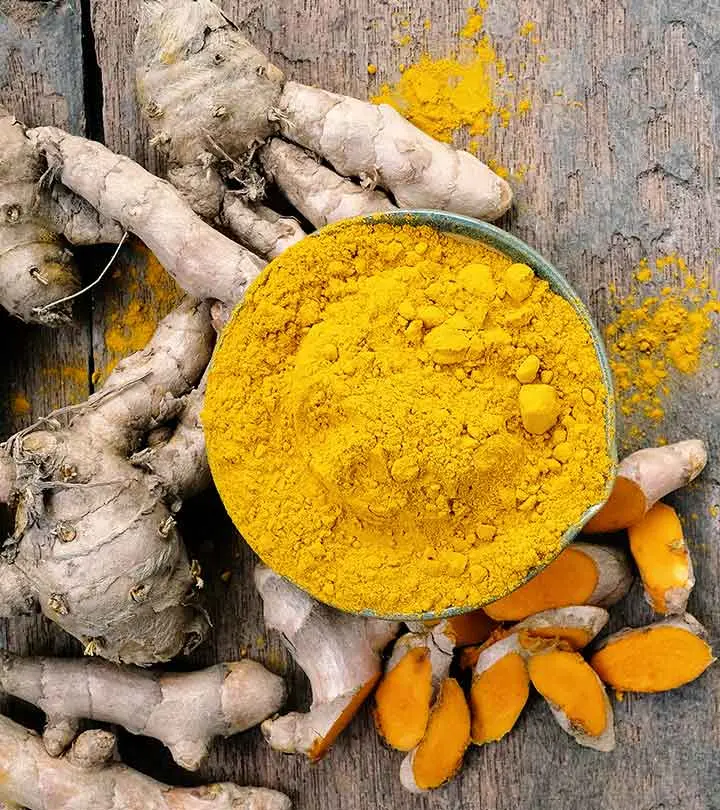








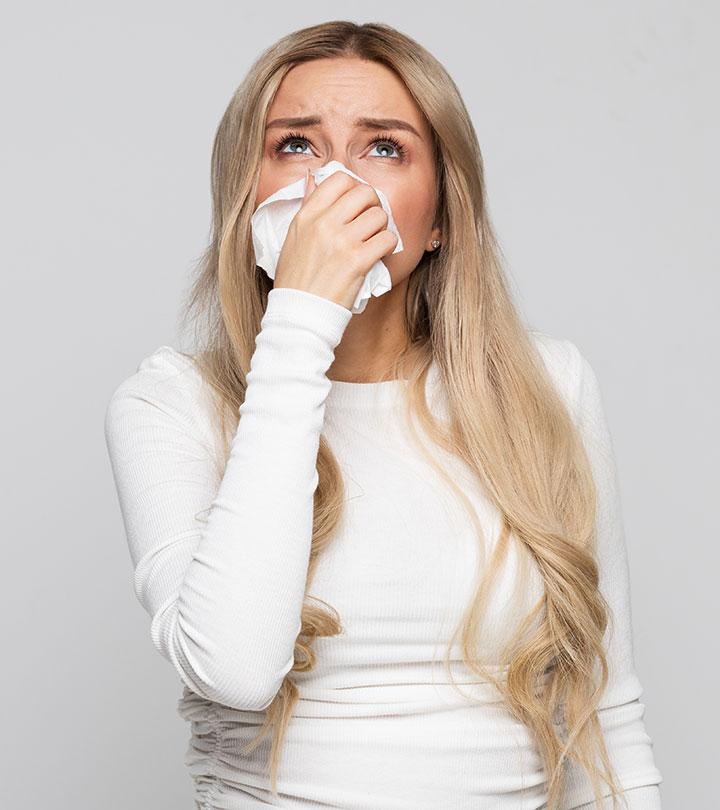



Community Experiences
Join the conversation and become a part of our empowering community! Share your stories, experiences, and insights to connect with other beauty, lifestyle, and health enthusiasts.